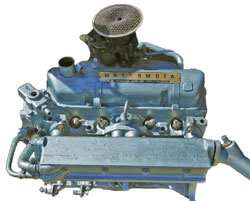| Petrol
engines suitable for installing into boats were
(and still are) developed from various Ford
engines. This allowed all of those potential
“Anglia” sailors out there to take to
the water in an engine that they were already
familiar with. These various Ford engines
were marinised by different manufacturers.
Amongst these were Parsons, CT Marine, Wortham
Blake and Watermota.

Watermota
There
are various types of Watermota petrol engines,
but the most popular are the Sea Wolf and the Sea
Tiger, the names of which were used on both the
pre-crossflow and crossflow Ford engines. The
105E pre-crossflow 997cc engine was called the Sea Wolf
and the 1500cc engine was called the Sea Tiger.
With the advent of the crossflow engine from Ford
in 1967 / 68, the Sea Wolf name was now used on
the 1100cc crossflow engine and the name Sea
Tiger was used on the 1600cc engine

To
differentiate the engines when ordering spares,
the pre-crossflow engines became known as the Sea
Wolf Mk 1 and Sea Tiger Mk 1 and the crossflow
engines, Sea Wolf Mk 2 and Sea Tiger Mk 2
The different versions of the
engines are easy to distinguish. The
pre-crossflow versions have the carburettor on
top of the exhaust manifold and the crossflow
versions have the carburettor on the opposite
side of the head to the exhaust manifold, the
gases flow across the head hence the term
'crossflow'.

Marinising
the Engine
The
Marine engine is not quite the same as your
standard car engine. There are certain things
that need to be done to make it safe to operate
within the environment of a boats engine bay.
The
most notable differences between a marine engine
and an automotive engine are the electrical
system, the cooling system, the exhaust system,
and the fuel system. Additionally, items such as
heads and cams are usually different.
Here
we will just cover a few of the differences to
give you a flavour of the modifications that are
made to a car engine to marinise it (this is not
intended to be an exhaustive list).
In
a car any petrol or vapour leak quickly disperses
through the bottom of the engine bay. In a boat,
the sealed engine compartment does not afford the
same luxury. Therefore the electrical system is
modified to eliminate the possibility of sparks
occurring within the system. Marine starters and
alternators are modified so they won't release
sparks and ignite and gas vapour that may be in
the engine compartment.
Marine
carburettors are modified so they won't flood
outside the carburettor. If there is a problem or
there is too much fuel in the carburettor, it
will flood back into the engine.
On
a boat there is a constant flow of new water
sucked up from the lake or the ocean which
circulates through the cooling system (raw water
cooling). This type of system is extremely
corrosive to the pump especially if the boat sees
salt water. An automotive style pump, with
its stamped steel impeller, would fail due to
corrosion in a short time. Therefore a marine
pump with a special ceramic seal, stainless steel
backing plate, and a bronze impeller to resist
corrosion is usually fitted. Two other areas of
the cooling system that are also marinised are
the head gasket and the core plugs (which should
be brass instead of steel)

|

